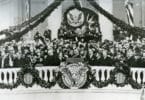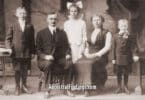Early Life and Background
James Abram Garfield was born on November 19, 1831, in a log cabin in Orange Township, Ohio (now Moreland Hills). He was the youngest of five children born to Abram Garfield, a farmer and canal worker, and Eliza Ballou Garfield. His father died when James was only 18 months old, leaving his mother to raise the family in poverty.
Eliza Garfield was a strong and determined woman who instilled in her children the values of hard work and education. Despite their financial struggles, she ensured that James received an education. Garfield worked various jobs, including as a carpenter and canal driver, to support himself and pay for his schooling.
Education and Early Career
Garfield’s thirst for knowledge led him to attend several schools, eventually enrolling at the Western Reserve Eclectic Institute (now Hiram College) in Ohio. He later attended Williams College in Massachusetts, where he graduated with honors in 1856. After completing his education, Garfield returned to the Eclectic Institute as a teacher and later became its principal.
In 1858, Garfield married Lucretia Rudolph, a former student, and daughter of a prosperous farmer. The couple had seven children: Eliza, Harry, James, Mary, Irvin, Abram, and Edward. Lucretia, known as “Crete,” was a supportive partner and played a significant role in Garfield’s personal and professional life.
Entry into Politics
Garfield’s interest in politics grew alongside his career in education. He studied law and was admitted to the bar in 1861. That same year, he was elected to the Ohio State Senate as a member of the Republican Party. His political career was soon interrupted by the outbreak of the Civil War.
Civil War Service
Garfield joined the Union Army in 1861, initially as a lieutenant colonel of the 42nd Ohio Volunteer Infantry. He quickly rose through the ranks due to his leadership and strategic abilities. Garfield’s most notable military achievement came at the Battle of Middle Creek in Kentucky, where he led his troops to a significant victory. By 1863, he had achieved the rank of major general.
Congressional Career
In 1862, while still serving in the army, Garfield was elected to the U.S. House of Representatives. He reluctantly resigned his commission and took his seat in Congress, where he served for nearly 18 years. During his time in Congress, Garfield became known for his oratory skills, his commitment to civil rights, and his advocacy for economic and educational reforms.
Garfield was a strong supporter of Reconstruction and worked to protect the rights of freed slaves. He also championed the gold standard and opposed the use of greenbacks, or paper currency not backed by gold.
Path to the Presidency
In 1880, Garfield attended the Republican National Convention as a supporter of John Sherman for the presidential nomination. However, after 35 ballots, the convention was deadlocked, and Garfield emerged as a compromise candidate. He was nominated on the 36th ballot and went on to win the election against Democratic candidate Winfield Scott Hancock.
Presidency (1881)
Civil Service Reform
One of Garfield’s primary goals as president was to reform the civil service system, which was plagued by corruption and patronage. He sought to implement a merit-based system for government appointments and reduce the influence of political patronage. Garfield’s efforts to clean up the civil service faced resistance from powerful political factions, but he remained committed to his principles.
Education and Economic Policies
Garfield was a strong advocate for education and believed in the importance of intellectual development for the nation’s progress. He supported federal funding for education and promoted policies to improve the nation’s educational system. Additionally, Garfield favored sound money policies and sought to reduce the national debt.
Foreign Policy
Garfield’s short time in office saw limited foreign policy initiatives, but he did express interest in expanding American influence and trade. He supported efforts to build a canal across Central America and strengthen ties with Latin American countries.
Assassination
Garfield’s presidency was tragically cut short on July 2, 1881, when he was shot by Charles J. Guiteau, a disgruntled office seeker, at the Baltimore and Potomac Railroad Station in Washington, D.C. Garfield survived the initial attack but suffered from infections and complications due to inadequate medical treatment. He endured a painful and prolonged illness before succumbing to his injuries on September 19, 1881, just six months into his term.
Personal Life and Character
Garfield was known for his intellectual curiosity, integrity, and dedication to public service. He was a devout Christian and a member of the Disciples of Christ, a denomination that emphasized education and social justice. His commitment to learning and moral principles shaped his approach to leadership and governance.
Garfield’s marriage to Lucretia was characterized by mutual respect and partnership. Lucretia played an active role in his political career, providing support and counsel. Despite the challenges they faced, including the tragic loss of their children, the couple maintained a strong and loving relationship.
Legacy and Impact
James A. Garfield‘s presidency, though brief, left a lasting impact on the nation. His efforts to reform the civil service laid the groundwork for future reforms, including the Pendleton Civil Service Reform Act of 1883. Garfield’s commitment to education and civil rights reflected his belief in the importance of intellectual and social progress.
Garfield’s tragic assassination highlighted the need for better security and medical care for public officials. His death also underscored the dangers of political patronage and the need for a more merit-based civil service system.
Interesting Aspects of Garfield’s Life and Presidency
Scholar and Orator
Garfield was one of the most intellectually accomplished presidents, having excelled in academia and public speaking. He was a skilled orator and debater known for his eloquence and ability to articulate complex ideas. His speeches and writings continue to be studied for their rhetorical and intellectual merit.
Advocate for Civil Rights
Throughout his political career, Garfield was a staunch advocate for civil rights and equality. He supported Reconstruction policies and worked to protect the rights of freed slaves. His commitment to civil rights was evident in his congressional speeches and his efforts to promote social justice.
Conclusion
James A. Garfield‘s life and presidency represent a story of resilience, intellect, and dedication to public service. From his humble beginnings in Ohio to his rise as a scholar, military leader, and president, Garfield’s journey is a testament to the power of education and moral conviction.
While his presidency was tragically cut short, Garfield’s efforts to reform the civil service and promote education and civil rights left a lasting legacy. His story serves as an enduring reminder of the importance of integrity, intellectual curiosity, and a commitment to the common good.
Recommended Books on James A. Garfield
“Destiny of the Republic: A Tale of Madness, Medicine and the Murder of a President” by Candice Millard
This gripping account by Candice Millard explores Garfield’s life, his assassination, and the medical malpractice that contributed to his death.
“Garfield: A Biography” by Allan Peskin
Allan Peskin’s comprehensive biography provides an in-depth look at Garfield’s life, political career, and presidency.
“The Garfield Conspiracy” by Owen Dwyer
This book delves into the political intrigue surrounding Garfield’s assassination and its impact on American politics.
“James A. Garfield” by Ira Rutkow
Part of The American Presidents Series, this concise biography by Ira Rutkow offers an accessible overview of Garfield’s life and presidency.
“The Unexpected President: The Life and Times of Chester A. Arthur” by Scott S. Greenberger
While primarily about Garfield’s successor, Chester A. Arthur, this book provides valuable context about Garfield’s presidency and the political environment of the time.






